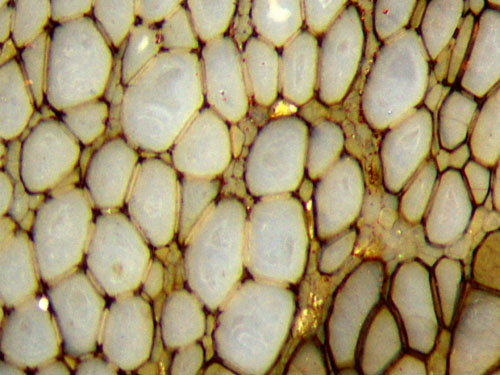Geologica Saxonica and "alternative facts"
The euphemistic term "alternative facts" for deliberately spread untrue
claims should not apply to a scientific journal but occasionally it
does. In order to avoid confusion, "alternative facts"
should be replaced by true facts as soon as possible.
The former coal and uranium mining in the Döhlen Basin near Dresden has
provided numerous compression fossils of the Lower Permian (Rotliegend)
[1]. Independent of the mining, large amounts of fossiliferous cherts
have been collected during the past 30 years, mostly with plant parts
in 3D-preservation. Only part of them have been thoroughly inspected up
to now. Some of them have been included into a comprehensive
publication [2].
One uncommon sample of scientific value is seen here
(Figs.1,2): a Psaronius
trunk centre fragment with
very well preserved tissue, the only find of
this quality in the Döhlen Basin. (Fig.1 shows
the rear face of the slab shown in [2], Abb.130A,
thus resembling its mirror image. This slab had been given to M.
Barthel years ago and is now registered under PB
2013/30 at the Museum für Naturkunde
Berlin. Two end parts are in the own collection.)

 Fig.1: Psaronius cross-section
with clearly seen conducting strands in parenchyma, fragment.
Fig.1: Psaronius cross-section
with clearly seen conducting strands in parenchyma, fragment.
Sample: W/19 (1991?), Part 2, Wilmsdorf golf course, Possendorf, Döhlen
Basin, image width 5cm,
(error: 0.45cm in Geologica Saxonica [2], Abb.130A).
Fig.2: Conducting strand cross-section,
tracheids with little
parenchyma in between.
Same sample as in Fig.1,
Part W/19.3, own collection,
image width 1.4mm,
(erroneous sizes in [2], Figs.130B,C).
The width of the conducting strands in Fig.1 is about
2mm
(erroneous width 0.4mm and 0.2mm in
[2], Figs.130B,C).
Immediately after the release of [2], information on the obviously
erroneous size data mentioned above and numerous others was submitted
to the author and to the editor-in-chief, J.-M.
Lange.
(A few details on relevant size data given in the German version of this contribution have
been omitted here.)
Author and editor did neither respond nor intend to
correct, under the pretense that the absurdly large
scatter of data is not due to their errors but to the natural
variability of the species. This is exposed as a
simple lie by these and other images. Anatomica l
details of one plant species do never differ by size factors up to 11 as the author tries to make believe, which would correspond to the difference between
hazelnut and coconut.
l
details of one plant species do never differ by size factors up to 11 as the author tries to make believe, which would correspond to the difference between
hazelnut and coconut.
Fig.3: Pinnule cross-section from a large frond of the tree fern Scolecopteris (which
is the foliage of Psaronius), rare
find with filled sporangia and a few scattered spores, with distinct
contour due to a crack running along the surface of the pinnule where
the cuticle provided a mechanically weak face making an easy crack
path. These clearly visible spores
are presented in [2] with three different sizes, every one of them erroneous.
Sample: B/51 (1995), 5.3kg,
Bannewitz, Döhlen Basin, own collection: B/51.2 (slab 14mm, parted), image
width 2.15mm. (See also: Maggot Fern spores.)
The reader of Geologica Saxonica and any other
scientific journal does not expect fake news. Errors must be corrected
as soon as possible. This should be the normal way of things but with Geologica
Saxonica the author is supposed to choose whether or not to correct his
errors.
There is nobody there to protect the reader from fake news. In
view of dozens of errors, author, redaktor, and
their supporters conspire in order to conceal their helplessness behind
a rabid attack involving abusive language [3]. Also they resort to the additional lie that the original samples were not available for corrections. They try to sweep the
dirt under the rug instead of trying to present clean palaeobotany.
Apparently, "alternative facts" are tolerated in parts of
professional palaeobotany although the watchful
eyes of lay people can easily recognize them as bogus claims.
Annotation Nov. 2017: Prof. J. Schneider, Editorial Board of Geologica
Saxonica, proclaims in connection with M. Barthel that even big
errors cannot in the least diminish the good reputation of an author [5].
H.-J.
Weiss
2018
[1] W. Reichel, M. Schauer: Das Döhlener Becken bei Dresden.
Bergbau in Sachsen 12(2007).
[2] M. Barthel: Die Rotliegend-Flora der Döhlen-Formation.
Geologica Saxonica 61(2), 2015, 108-229.
[3] J.-M. Lange, M. Barthel, R. Rößler, u.a.: Stellungnahme
zur Kritik von Herrn Dr. Weiß am Heft 61(2) der Geologica Saxonica, sent via U. Linnemann, 6.4.2017.
[5] J. Schneider: Schreiben an 10 Empfänger, 24.10.2017.

 Fig.1: Psaronius cross-section
with clearly seen conducting strands in parenchyma, fragment.
Fig.1: Psaronius cross-section
with clearly seen conducting strands in parenchyma, fragment. l
details of one plant species do never differ by size factors up to 11 as the author tries to make believe, which would correspond to the difference between
hazelnut and coconut.
l
details of one plant species do never differ by size factors up to 11 as the author tries to make believe, which would correspond to the difference between
hazelnut and coconut.